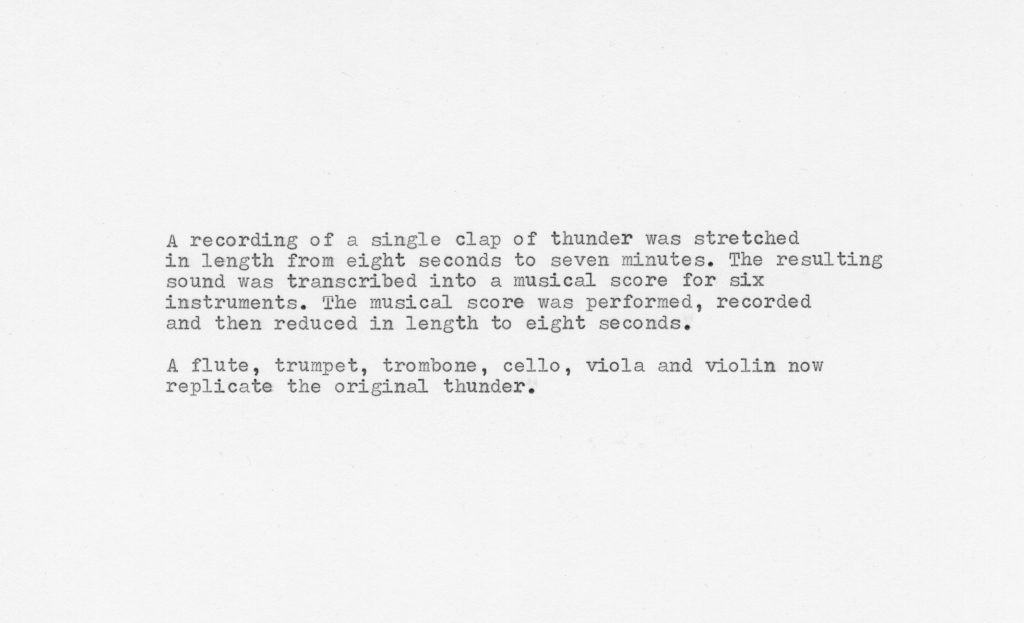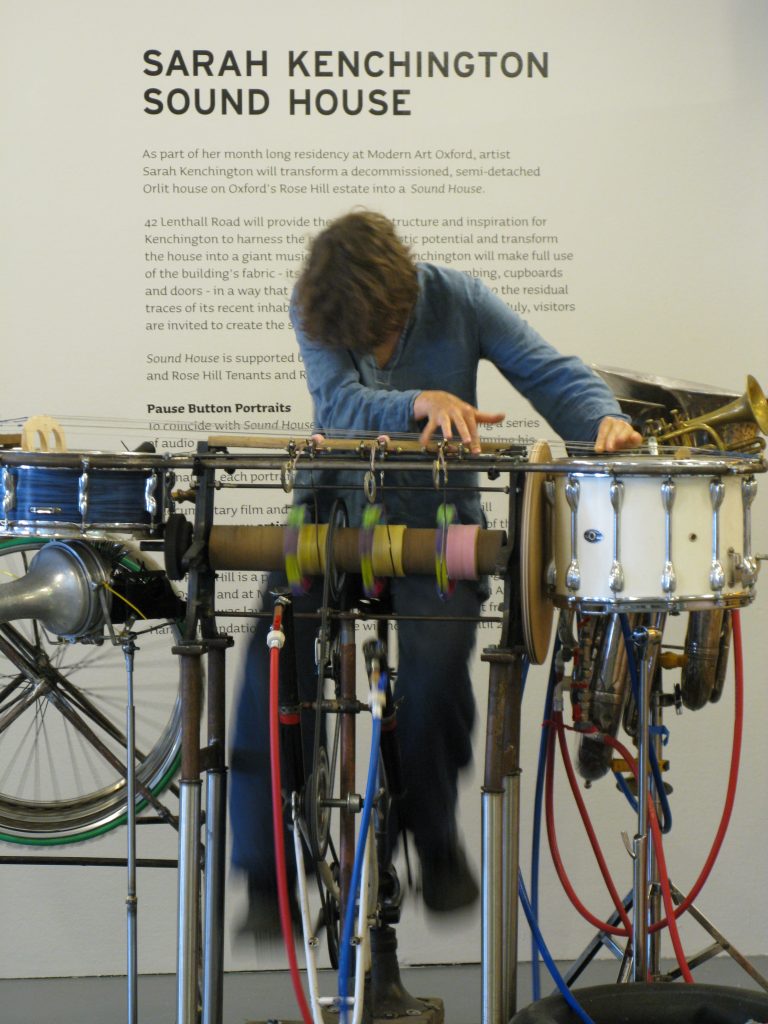Ask an Artist: Julie Freeman
Commissioned as part of our summer programme, Boundary Encounters, Julie Freeman’s Another Present is an intimate listening experience, combining sonic works by women artists from our archive, audience data and field recordings. This new sound work reverberates through wooden sculptural forms, inspired by shapes created by the artist’s body. The work incorporates, and celebrates, previously commissioned audio works by artists Sarah Kenchington, Ann Liselgaard and Hannah Rickards from Modern Art Oxford’s archives.
Here, Freeman discusses the work and its meaning as well as giving us an insight into her creative process.
Can you explain the meaning behind the title of your commission, Another Present?
The title Another Present comes from understanding that the past doesn’t have to be a blueprint for the future – it’s just another present that existed at another time.
I think it’s a beautiful idea that if you can hold on to the past, you can also let it go. I felt it was important that this commission must be a tactile and ‘holdable’ work which physically embodied the past.
In considering ideas for this commission, you’ve questioned how we learn from the past – who we are learning from, and why their successes are deemed to be successful. Could you tell us more about how this has informed your own creative process?
Actively looking at the way we encounter the past through data means considering the broad and subjective contexts in which it has been collected (including who the collectors are, and who and what they know). Thanks to growing media coverage of discrimination within AI and machine learning systems we are more aware than ever of the biases that exist in datasets, as well as the algorithmic instructions written to learn from and analyse them. We are still seeing the legacy of (and current) patriarchal, colonial and inequitable structures present in contemporary data collection technologies.
The same is true of any archive. I spent a couple of days looking through the archive at Modern Art Oxford, thinking about what is recorded and how – and who has been included. Delving through historic correspondence and documentation was fascinating, and revealing! There are so many factors to consider when thinking about the value of the data in a gallery archive: the subjectivity of the curators of the time, the geographic convenience of artists and their work, the communication technologies, the chancers (we found a letter from a sound artist self-declaring that he should be in the upcoming show as he was the best in the field – it worked, the curator included him!). For Modern Art Oxford, the personality of the data collected is a rich and important part of its history – the archive represents the people, the politics, the technologies and the social agendas of the times. It was a joy to see the immediate and intimate correspondence of faxes with notes and diagrams scribbled directly on an original letter and then faxed back and forth. And it was an honour to read the genuine excitement of artists, technicians and curators creating something magical for the public – in this way the archive provided a specific and affecting snapshot of the past.
Modern Art Oxford invited me to make a work in response to their archival and participation data. Through exploring statistical data on their past audiences, I accumulated sets of values which were meaningful to me – the difference between male and female identifying visitors. On average females make up just under 70% of all visitors (this is still true today), and yet the majority of exhibiting artists, especially in past decades, have been males. In one of the three final works, these numerical values are translated into a synthetic sound composition – sets of tones of varying frequencies that produce a strong resonance with the material of the plywood sculpture. Additional synthetic sound has been created from abstracting and processing language from past reports including this line from a 1993 report which made me laugh out loud “MOMA exhibitions are felt to be much less difficult to understand than modern art usually is”. Thank goodness for artists that people like a bit of ‘difficult’ in their lives.
You’ve selected existing audio by artists Sarah Kenchington, Ann Liselgaard, and Hannah Rickards, from Modern Art Oxford’s archive. Could you tell us how you’ve combined this rich selection of materials with your own personal recordings of Oxford for your new sonic work?
I became particularly interested in sound works by women artists held in the archive. The largest sculpture in my commission Another Present features sound works by Ann Liselgaard, Sarah Kenchington and Hannah Rickards, all previously commissioned by Modern Art Oxford. Resonating with my own practice, these three artists bring to life past experiences, spaces and natural phenomena through sound, and in the case of Rickards and Kenchington translated into music. Thunder (2005) by Hannah Richards translates the sound of an eight-second thunderclap into a seven-minute passage of music. In Audible Light (2000) by Ann Liselgaard you can hear the sounds of the artist going about everyday activities in a domestic space. Sarah Kenchington’s site-specific installation Sound House (2009) transformed a recently vacated family home that was due for demolition into a multi-faceted musical instrument. Thanks to the generosity of the artists, these three sound works can now be heard and felt in a new way as they are embedded in the wooden sculpture. You can lean on Hannah’s thunder, hold onto Sarah’s house, and resonate with the intimacy of Ann’s domestic recording.

Hannah Rickards, Thunder, 2005. Image courtesy the artist
Boundary Encounters explores edges that come together, multiple forms of learning and archival information. While developing this commission in Oxford, I have continually returned to thoughts of my own past – and particularly to my dad who died in 1995. I was 23 and his death had a profound impact on my life. We had a shared love of technology and nature, and my first major work was sited at his lake where I collected data from fish to create music (The Lake, 2005). The piece became a part of my grieving process to help me connect with him. Dad’s ashes were scattered (or more accurately billowed out of a cheap plastic container!) from Medley Bridge, just a couple of kilometres down the river from Modern Art Oxford. Medley was his favourite place to fish, and we took comfort in the idea that his ashes, like him, would not be still but would continue their journey down the Thames and out into the oceans. I have created a composition using newly recorded local sounds that represent my past – my dad, the river at Medley Bridge, my familiar. In doing this I too can take part in a process of letting go: this is a moment of self-care in what I consider an altruistic work.

Sarah Kenchington, Sound House, 2009. Image courtesy the artist.
Another Present brings these encounters with the past together in a set of sonic works that encourage participation, shared experience, touch and physical exploration. Sounds are felt and heard through three wooden organic sculptures, inspired by shapes I made with my body. Each has a resonator device attached, which turns the entire sculpture into a tactile speaker. Situated throughout the gallery, they can be touched and lent against. These objects are vessels for us to hold the past, to perhaps feel it and perceive it differently, to hold space and then to let go.
